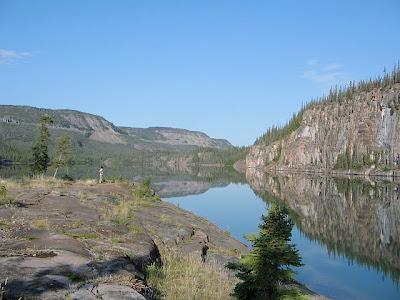By:
Tom
Sarah and I are steadily working to get to a position where we've locked in trip dates and are ready to make reservations.
On Wednesday Sarah tried out a Prijon Seayak at the local pool session. The Seayak has a
reputation as a tough and somewhat slow boat. It is a bit over 16 feet long and 24 inches wide. The outfitter has a Seayak available for her and a Prijon
Kodiak available for me. I learned to paddle in a Kodiak. It was the first kayak I bought and I still paddle it on occasion. I've done two week-long kayaking camping trips in Lake Superior in my Kodiak and it performed superbly. I'm quite fond of the Kodiak in particular and the Prijon line in general.
Sarah remained to be persuaded. The first Seayak Sarah tried was a new model. She hated it. The edge of the cockpit seemed to come up almost to her armpits and it was apparent that the boat did not become her.
Kayak Dave, the pool session organizer, then had her try out an earlier version of the Seayak. Sarah bonded with this boat. It fit her much better and she immediately displayed much more confidence in the boat. Before long she was working on rolls and sharp, crisp turns. Hopefully, our outfitter will have an old model Seayak. Otherwise, Sarah may be scouring Yellowknife for a suitable kayak.
The next day we met for lunch. She pulled out her chart and I pulled out the topos. We agreed on a tentative plan that will have us spending time in both Christie Bay and McLeod Bay as well as doing an interesting portage out of Wildbread Bay to access Christie Bay. The route will give us plenty of options and a varied land and water environment.
It is a bit old-fashioned in the day of Google Earth and GPS units to be fiddling around with hard copy charts and maps. Yet, it is great to pat down a map and have the whole sweep of possibilities laid out before you. We measured and discussed and reached a good realization that neither of us has any goal (e.g., minimum mileage) or destination (e.g.,
Fort Reliance at the end of the East Arm) of overriding importance. This absence of burning ambition is important from a risk management perspective because it means we (hopefully) will be a bit less inclined to take undue paddling risks.
I
learned my lesson in Georgian Bay when it comes to letting ambition override good common sense. I have no desire to repeat the experience in the GSL. Yet, I doubt that anyone will think we are lollygaggers. I expect that we will cover a fair number of miles and push ourselves a bit to explore the new (to us) GSL environment. It is a bit strange for me--and I speak only for myself--to be planning a trip where the primary goal is to be in the place rather than meet some arbitrary goal--e.g., complete a circumnavigation or cover X miles of coastline.
Sarah wants to take an ACA Instructors Certification Exam that has been scheduled for Labor Day. We had tentatively hoped to end our GSL adventure that same weekend. Either the ICE will be rescheduled or we will move up our trip. Pushing up the dates means warmer weather, more daylight. . . and more bugs.
Hopefully, the issue of dates will be resolved soon. We'll then reach out to our outfitter and local airline to lock in boats, lodging and flights to and from the East Arm. We can then turn our attention to planning how to live and paddle safely and well for two weeks on wilderness water.














